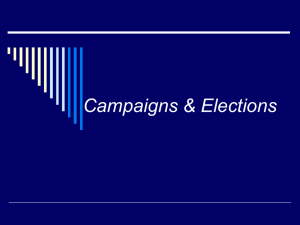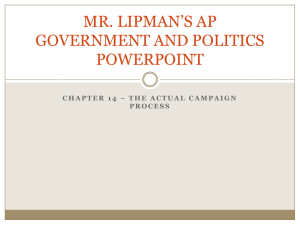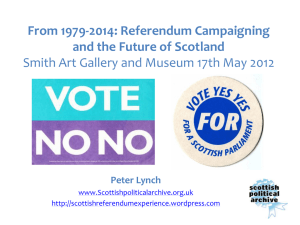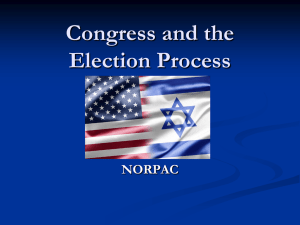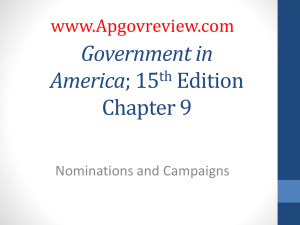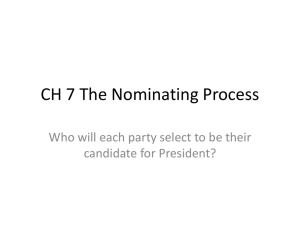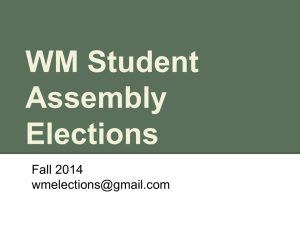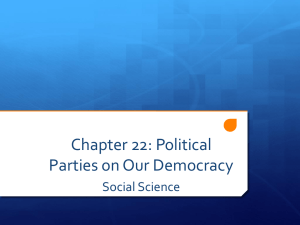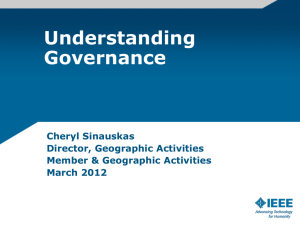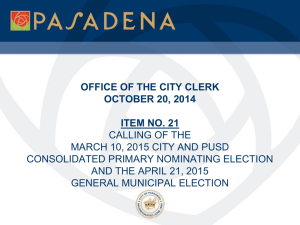Understanding Elections
advertisement
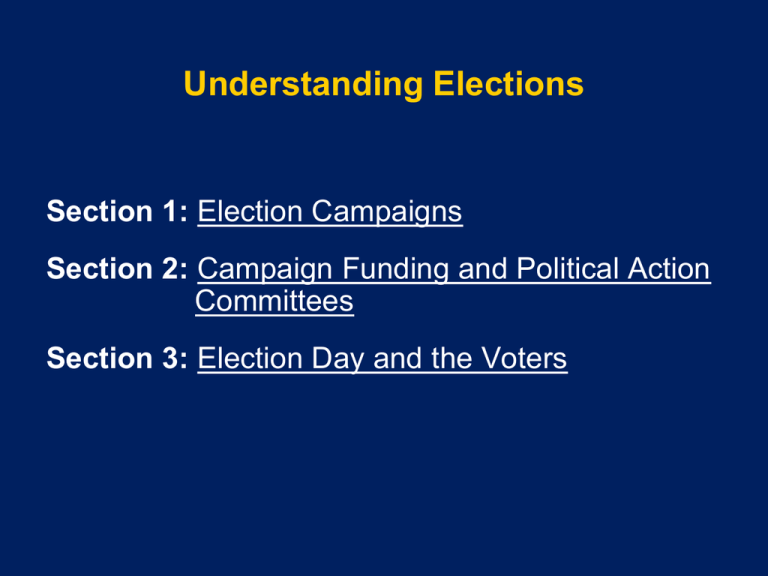
Understanding Elections Section 1: Election Campaigns Section 2: Campaign Funding and Political Action Committees Section 3: Election Day and the Voters Election Campaigns The purpose of election campaigns is to help the public learn about the candidates, so that voters can make an informed decision on election day. Candidates today take advantage of media exposure and polling in order to influence the voters and get elected to public office. Campaign Planning A campaign informs the public about the candidate and the party’s platform, their stand on important topics. Campaign Staff • Campaign Manager • Finance Chair • Pollster • Media Coordinator • Scheduler • Issue Advisers, others Campaign Strategy • Identify Supporters Conduct polls to identify where most support is • Target the Message Use polls and focus groups to learn which issues most important to supporters. • Package the Candidate Manage media coverage of candidate’s image and message Conducting a Campaign On the Campaign Trail Candidates spend most of campaign time on swing states: where support for candidates is about equal, or in states where their support is greatest • Tackling the Issues – Candidates use stump speeches, or standard speeches usually less than 20 minutes long, express candidate’s beliefs On key issues. – Many candidates use slogans • Negative Campaigning – Candidates may use negative campaigning, attacks on opposing candidate’s weaknesses Conducting a Campaign Campaigns and the Media Campaign’s media coordinator uses voters’ ages to determine which type of media to use to reach them. – Broadcast Media • Television, photos, radio • Media often use sound bites of candidates’ speeches – Print Media • Newspapers, magazines, especially ads • Often more detailed than broadcast; editorials influential – The Internet • Blogs, online editions of print media, TV news Polls and Polling Polls can show where support is weakest; show which demographic may support the candidate; influence voters Campaign Funding and Political Action Committees Money plays a major role in election campaigns. Candidates and their staff must carefully decide where the campaign will get money and how it will use this money. Funding Election Campaigns Election campaigns can be very expensive. Where the Money Comes From • Individual Donations: Largest source of funds; individuals contribute directly or by hosting fund-raisers • Contributions by PACs: Second most important source of funds • Political Party Contributions: Limited amounts funded by committees within a political party • Public Funding: Comes from federal government through income tax; only available to presidential candidates Campaign Finance Laws Early Campaign Finance Reform • 1907: Congress first restricts campaign funds; expanded restrictions in 1940s • 1971: Congress passed FECA, requires candidates, PACs, political parties to report contributions received above certain amount • FECA reports must identify contributors FECA Amendments • 1974: FEC (Federal Election Commission) created • 1979: allowances made for unlimited spending on party-building activities Soft Money No restrictions placed on donations not given directly to candidates Bipartisan Campaign Reform Act 2002: banned soft money raised for issue ads Interest Groups and Election Campaigns Political Action Committees Many interest groups have a PAC. How PACs Function Collects funds; distribute to political parties or candidates Leadership PACs Not official campaign organizations; can raise unlimited funds Influence of PACs Allow interest groups greater voice in government; critics say too powerful Elections and 527 Groups Tax-exempt organizations that have no limit on political donations Controversies over 527 Groups First came to forefront in 2004 election (e.g., MoveOn.org) Impact of 527 Groups Critics blame for increase in negative campaigning Campaign Reform and the Media BCRA requires ads to identify who is paying for them; supporters hope this reduces negative campaigning Interest Groups and Election Campaigns Political Action Committees • Many interest groups have a PAC. Leadership PACs How PACs Function • Collect funds • Distribute to political parties or candidates Influence of PACs • Not official campaign organizations • Allow interest groups greater voice in government • Can raise unlimited funds • Critics say too powerful Interest Groups and Election Campaigns Elections and 527 Groups • Tax-exempt organizations that have no limit on political donations Impact of 527 Groups • Critics blame for increase in negative campaigning Controversies over 527 Groups • First came to forefront in 2004 election (e.g., MoveOn.org) Campaign Reform and the Media • BCRA requires ads to identify who is paying for them • Supporters hope this reduces negative campaigning Election Day and the Voters Voting is one of the main responsibilities of U.S. citizenship. Being a part of the voting process and taking an active role in electing public officials helps give all Americans a voice in their government. Election 2000 A Historic Election Night The results hinged on which candidate won Florida and its 25 electoral votes. After announcing different winners several times, the media could not declare a winner. It took more than a month before the outcome in Florida was decided. The Recount Controversy Bush v. Gore • Florida officials used machines to recount ballots; results showed Bush as the winner • Florida Supreme Court ordered hand recount; decision was appealed • Democrats asked for hand recount; high number of faulty ballots • U.S. Supreme Court declared Florida Supreme Court’s order unconstitutional • Each party filed lawsuit to force or prevent recounts • Gore accepts defeat Political Participation The United States is a democratic republic. In order to function well, its citizens must participate in politics. Voting Rights and Responsibilities • Voting rights extended several times in U.S. history Voting Rates • 45 percent of eligible voters vote in presidential elections, less in nonpresidential or local elections • Voters under 25 least likely to vote Impact of Voting • Biggest impact of voting on local elections, which have the most direct effect on people’s lives Beyond the Right to Vote Working on Campaigns • Activities include working in campaign office, making phone calls, talking to voters Working at the Polls • Poll workers (hired employees) and Poll watchers (volunteers) at polls on election day Becoming a Candidate • One way citizens can become more involved The Voting Process Steps to Voting • Registering to Vote Americans must take initiative to register • Casting a Ballot Done either by casting paper ballot or by using mechanical voting machine One Person, One Vote • Reapportionment Redistribution of congressional seats due to population changes • Redistricting Drawing new boundaries for legislative districts Campaigns on Election Day • Election Day Activities Level of activity in an area depends on candidate’s or opponent’s level of support • Getting Out the Vote Volunteers phone supporters to remind them to vote

